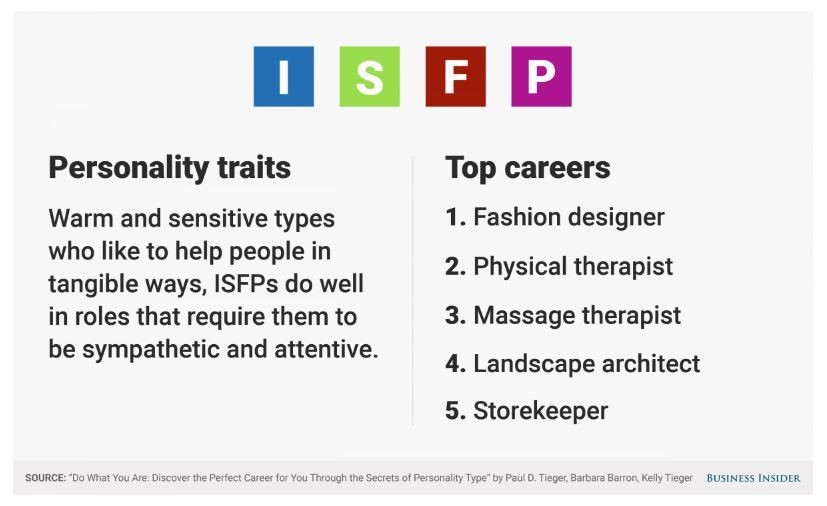https://www.16personalities.com
CAMPAIGNER PERSONALITY (ENFP, -A/-T)
It doesn’t interest me what you do for a living. I want to know what you ache for – and if you dare to dream of meeting your heart’s longing. It doesn’t interest me how old you are. I want to know if you will risk looking like a fool – for love – for your dreams – for the adventure of being alive.
The Campaigner personality is a true free spirit. They are often the life of the party, but unlike types in the Explorer Role group, Campaigners are less interested in the sheer excitement and pleasure of the moment than they are in enjoying the social and emotional connections they make with others. Charming, independent, energetic and compassionate, the 7% of the population that they comprise can certainly be felt in any crowd.

You Can Change the World With Just an Idea
More than just sociable people-pleasers though, Campaigners, like all their Diplomat cousins, are shaped by their Intuitive (N) quality, allowing them to read between the lines with curiosity and energy. They tend to see life as a big, complex puzzle where everything is connected – but unlike Analyst personality types, who tend to see that puzzle as a series of systemic machinations, Campaigners see it through a prism of emotion, compassion and mysticism, and are always looking for a deeper meaning.
Many other types are likely to find these qualities irresistible, and if they’ve found a cause that sparks their imagination, Campaigners will bring an energy that oftentimes thrusts them into the spotlight, held up by their peers as a leader and a guru – but this isn’t always where independence-loving Campaigners want to be. Worse still if they find themselves beset by the administrative tasks and routine maintenance that can accompany a leadership position. Campaigners’ self-esteem is dependent on their ability to come up with original solutions, and they need to know that they have the freedom to be innovative – they can quickly lose patience or become dejected if they get trapped in a boring role.
Don’t Lose That ’Little Spark of Madness’
Luckily, Campaigners know how to relax, and they are perfectly capable of switching from a passionate, driven idealist in the workplace to that imaginative and enthusiastic free spirit on the dance floor, often with a suddenness that can surprise even their closest friends. Being in the mix also gives them a chance to connect emotionally with others, giving them cherished insight into what motivates their friends and colleagues. They believe that everyone should take the time to recognize and express their feelings, and their empathy and sociability make that a natural conversation topic.
The Campaigner personality type needs to be careful, however – if they rely too much on their intuition, assume or anticipate too much about a friend’s motivations, they can misread the signals and frustrate plans that a more straightforward approach would have made simple. This kind of social stress is the bugbear that keeps harmony-focused Diplomats awake at night. Campaigners are very emotional and sensitive, and when they step on someone’s toes, they both feel it.
Campaigners will spend a lot of time exploring social relationships, feelings and ideas before they find something that really rings true. But when they finally do find their place in the world, their imagination, empathy and courage are likely to produce incredible results.
Your Results

Campaigners You May Know
















CAMPAIGNER STRENGTHS AND WEAKNESSES
Campaigner Strengths

- Curious – When it comes to new ideas, Campaigners aren’t interested in brooding – they want to go out and experience things, and don’t hesitate to step out of their comfort zones to do so. Campaigners are imaginative and open-minded, seeing all things as part of a big, mysterious puzzle called life.
- Observant – Campaigners believe that there are no irrelevant actions, that every shift in sentiment, every move and every idea is part of something bigger. To satisfy their curiosity, Campaigners try to notice all of these things, and to never miss a moment.
- Energetic and Enthusiastic – As they observe, forming new connections and ideas, Campaigners won’t hold their tongues – they’re excited about their findings, and share them with anyone who’ll listen. This infectious enthusiasm has the dual benefit of giving Campaigners a chance to make more social connections, and of giving them a new source of information and experience, as they fit their new friends’ opinions into their existing ideas.
- Excellent Communicators – It’s a good thing that Campaigners have such strong people skills, or they’d never express these ideas. Campaigners enjoy both small talk and deep, meaningful conversations, which are just two sides of the same coin for them, and are adept at steering conversations towards their desired subjects in ways that feel completely natural and unforced.
- Know How to Relax – It’s not all “nature of the cosmos” discussions with Campaigners – people with this personality type know that sometimes, nothing is as important as simply having fun and experiencing life’s joys. That Intuitive trait lets Campaigners know that it’s time to shake things up, and these wild bursts of enthusiastic energy can surprise even their closest friends.
- Very Popular and Friendly – All this adaptability and spontaneity comes together to form a person who is approachable, interesting and exciting, with a cooperative and altruistic spirit and friendly, empathetic disposition. Campaigners get along with pretty much everyone, and their circles of friends stretch far and wide.
Campaigner Weaknesses

- Poor Practical Skills – When it comes to conceiving ideas and starting projects, especially involving other people, Campaigners have exceptional talent. Unfortunately their skill with upkeep, administration, and follow-through on those projects struggles. Without more hands-on people to help push day-to-day things along, Campaigners’ ideas are likely to remain just that – ideas.
- Find it Difficult to Focus – Campaigners are natural explorers of interpersonal connections and philosophy, but this backfires when what needs to be done is that TPS report sitting right in front of them. It’s hard for Campaigners to maintain interest as tasks drift towards routine, administrative matters, and away from broader concepts.
- Overthink Things – Campaigners don’t take things at face value – they look for underlying motives in even the simplest things. It’s not uncommon for Campaigners to lose a bit of sleep asking themselves why someone did what they did, what it might mean, and what to do about it.
- Get Stressed Easily – All this overthinking isn’t just for their own benefit – Campaigners, especially Turbulent ones, are very sensitive, and care deeply about others’ feelings. A consequence of their popularity is that others often look to them for guidance and help, which takes time, and it’s easy to see why Campaigners sometimes get overwhelmed, especially when they can’t say yes to every request.
- Highly Emotional – While emotional expression is healthy and natural, with Campaigners even viewing it as a core part of their identity, it can come out strongly enough to cause problems for this personality type. Particularly when under stress, criticism or conflict, Campaigners can experience emotional bursts that are counter-productive at best.
- Independent to a Fault – Campaigners loathe being micromanaged and restrained by heavy-handed rules – they want to be seen as highly independent masters of their own fates, even possessors of an altruistic wisdom that goes beyond draconian law. The challenge for Campaigners is that they live in a world of checks and balances, a pill they are not happy to swallow.
CAMPAIGNER RELATIONSHIPS
When it comes to relationships, there’s hardly anyone around who is more excited than Campaigners to share with their partners the bounty of ideas and eye-opening experiences that life has to offer. For people with the Campaigner personality type, relationships are a joyous process of mutual exploration and imagination, a chance to connect with another soul. Campaigners take their relationships seriously, and are known for their uninhibited and unshakeable devotion to the people to whom they’ve committed their hearts.
In the dating phase, if Campaigners can be said to tolerate such a formal process to begin with, they will show these qualities by showering their new flames with affection, and will do everything they can to build a strong relationship by demonstrating their devotion and reliability by whatever means available.

You Cannot Live Without a Fire
Long-distance relationships are quite common among Campaigners, as they view physical distance as just another idea, no match for concepts like love. This gives them the chance to demonstrate their commitment, both by staying true despite the physical separation, and with overtures of effort to surprise their partners, crossing that distance on a whim. These are demonstrations of Campaigners’ mystery, idealism and deep emotion, and such efforts often keep the flames of a relationship burning bright.
People with the Campaigner personality type express these ideals sexually as well, exploring the physical with imagination and passion, viewing these times together as a chance to let their feelings for each other shine, sharing their love and affection. Campaigners will willingly experiment with their partners, even early in a relationship, but they can also be oddly perfectionistic, believing that these physical acts are a representation of their deeper love, and as such should not be performed carelessly. This perfectionism is also a reflection of their sensitivity, their desire to not disappoint, and Campaigners appreciate a well-placed compliment.
Not everyone can handle the excitement, occasional neediness, and emotional ups and downs that this philosophy entails, whether long-distance or long-term, mystical or physical. Campaigners constantly explore new ideas and improvements, fantasize about future possibilities – in dating, this tendency to look at potential rather than the present can be self-defeating, and their spontaneity makes it harder to stay focused on their end goal of a long-term relationship. If their partners aren’t able to reciprocate these acts of excitement and devotion, Campaigners will likely end up feeling unhappy and misunderstood.
So, You Think You Know the Real Me?
Campaigners go all-in with their relationships, and if they fall apart despite their efforts, they can end up plagued with questions about why the relationship failed and what they could have done differently – without a buoy, these thoughts can crush Campaigners’ self-esteem as they sink into depression. It’s important for Campaigner personalities, as with anyone, to remember that relationships are in all ways mutual – mutual interest, mutual growth, and mutual responsibility – and they can’t be solely accountable.
After a trial like this, Campaigners may be reluctant to open up and commit, and it can take years for a partner to navigate their bewildering depth and intensity, falsely believing that Campaigners’ enthusiasm and apparent openness means that they wear everything on their sleeves. The reality is that Campaigners’ spontaneity, the seeming inconsistency and erraticism the untrained eye sees, isn’t a product of flightiness or lack of depth, but the opposite – it is a drive to express ideas about a mystical, all-encompassing energy, in the confines of a physical world, and underlying it all is the uniting principle of love, expressed in many different ways, but unshakeable and infinite at its core.
CAMPAIGNER FRIENDS
As friends, Campaigners are cheerful and supportive, always sharing and developing ideas, and staying open-minded, taking in others’ thoughts and feelings. This warmth and sincerity makes people with the Campaigner personality type masters of drawing people out of their shells, and as a result they tend to have a huge circle of friends.
An Exciting Adventure
More outgoing types will naturally gravitate towards them, but Campaigners will also go to great lengths and be surprisingly persistent in their efforts to get to know more reserved personalities. Their ability to tune into others and speak their language with that characteristic infectious enthusiasm helps them in this endeavor, and the allure of mystery that reserved types, especially Introverted Intuitives, bring to the table will keep Campaigners intrigued for years. These personality types may never be able to reciprocate the breadth of human interest that Campaigners present, but they do appreciate Campaigners’ efforts.
But Campaigners’ interest in others can be a double-edged sword – this pure idealism comes with certain expectations, and too often Campaigners hold their friends in an unrealistic light, expecting them to keep up with the constant flow of ideas and experiences that they consider integral to life. Campaigners put their whole hearts into their friendships, and it can come as a shock for them to find that their friends aren’t the flawless Titans that they believed them to be. Whether it’s simple social fatigue or a focus on the physical and the practical instead of the mystical, people with the Campaigner personality type can find themselves disappointed by what they see as a lack of substance beneath the surface.

Campaigners tend to get deeply involved in others’ lives, going to great lengths and efforts to be the selfless, caring and supportive people they are, and all the while forget to take care of themselves. Both in terms of basic needs like financial stability and rest, as well as more emotional needs like mutual understanding and reciprocation, Campaigner personalities tend to give much more of themselves than most are even capable of giving back. This sort of imbalance isn’t sustainable, as (seemingly) one-sided generosity often leads to criticism and resentment on both sides.
Making Life Spectacular
Luckily, Campaigners are open-minded and sincere enough in their friendships, and connect with and understand even their acquaintances well enough, that they recognize that not everyone expresses themselves in the same ways, and that that’s okay. Their sensitivity may make it too challenging to play with more critical and argumentative personalities, such as strongly expressed Thinking (T) and Judging (J) types, but they do appreciate, even cherish, the company of most anyone who appreciates theirs, and the adventures and experiences they have together are the stuff a good life is made of.
CAMPAIGNER PARENTS
If there is anything that makes Campaigners great parents, it’s the sense of wonder they have for all things new and beautiful, a sense that they will be able to share with their children every day as they learn and grow. Throughout their children’s lives, Campaigners provide a combination of almost overwhelming love and support, and an unstructured environment revolving around freedom and creativity. This in no way means that people with the Campaigner personality type will simply leave their children to their own devices without guidance – rather, Campaigner parents want to share in their children’s perspective, share in a world without bounds.
Campaigner parents are playful and warm, and love to see their children excited, playing in and experimenting with the world around them. It is likely that Campaigner parents will encourage this play and growth by suggesting activities and lessons.

While they often enough recognize the value of structure and predictability, Campaigner parents are unlikely to have the heart (or as they may see it, the lack of heart) to establish these limitations themselves. They may need to depend on their partners to provide some necessary guidelines and discipline from time to time, but Campaigner parents will always have the advantage of their open-minded and empathetic nature, making them not just parents, but friends who their children feel comfortable confiding in. They needn’t always depend on their children broaching the subject either, as Campaigners have a natural skill in spotting emotional disharmony or physical discomfort in others.
Go On, Spread Your Wings
As their children approach the teenage years, all this emotion and attention can start to cloy, and their children may seek a more private independence. This can be a challenge for people with the Campaigner personality type – they have strong emotions, and invest those emotions heavily in the things and people they care about. While they may not be big on using proven ideas, Campaigners do like to see whether or not their ideas work, and this applies to their thoughts on parenting, too. As their adolescent children withdraw, they leave an unsolved mystery that can last for years, leaving their Campaigner parents wondering if their ideas on raising their children actually work, actually result in happy, independent and creative adults.
Luckily for them, so long as they raise their children with a sense of productive independence, rather than an aimless, against-the-grain antipathy, Campaigners will find that their children have developed a strong sense of self and self-worth, going confidently out into the big, wide world at their own pace and in their own style, knowing that they have both themselves and their Campaigner parents to depend on.
CAMPAIGNER CAREERS
“Can’t I fly helicopters AND be an oceanographer who writes songs and cooks?” It’s a big world out there – perhaps even a little too big. Campaigners are fascinated by new ideas, both in terms of developments in fields they are already familiar with, and when new subjects come along. The trick for people with the Campaigner personality type is to take advantage of this quality, this wonder with the magnificent breadth and detail in the world, and to use it to propel themselves further and deeper than others are willing or able to go.

The Opening of a Door Can Be a Wonderfully Joyous Moment
Chief among Campaigners’ talents is their people skills, a quality that is even more valuable now than ever. Even in traditional Analyst strongholds like engineering, systems analysis and the sciences, Campaigners’ ability to network and match the communication styles of their audience means that even as they explore new challenges on their own, they will be able to work with others, explore others’ perspectives and glean new insights into their projects. Much of modern progress stems from incorporating other studies into typically disassociated fields, and no one is better equipped to merge broad interests than talented, energetic and future-minded Campaigners.
And while Thinking types may be better at applying logic to systems and machines, people with the Campaigner personality type are able to apply that same logic to human interactions and networks, using their exceptional social perception to find out what makes people tick. This lends Campaigners a solid foothold in any human science or service, from psychology, counseling and teaching to politics, diplomacy and detective work. All of these fields have another important similarity: they are in constant development, shifting, presenting new angles and new approaches. It’s simply not possible to be good in these fields and content with the way things are, and this is where Campaigners truly shine.
Too Many Bosses, Too Few Workers
Where Campaigners do not shine is in systems of strict regimentation and hierarchy, such as military service. Campaigners thrive on the ability to question the status quo and explore the alternatives, and if this is a quality that is not just unappreciated but actually frowned upon, this will not only make them unhappy, but it may even threaten their emotional stability. Repetition, predictability, boredom… while some Sentinel types may appreciate predictability and clear hierarchies, these are not selling points for Campaigners. People with the Campaigner personality type need to feel like they’re pushing boundaries and exploring ideas, and should focus on interests and careers that encourage that.
Many more career options satisfy these needs, and not just the scientific ones – writing, journalism, acting and TV reporting all give Campaigners a chance to explore something new every day and stir the pot a little while they’re at it. It may come to pass though, that the best way forward for Campaigner personalities is to establish themselves as entrepreneurs and consultants, blazing their own trails and taking on whatever project is most fascinating. So long as they get to use their people skills, identify and achieve their own goals and inspire their colleagues and followers, Campaigners will be happy.
CAMPAIGNERS IN THE WORKPLACE
There are two basic things that Campaigners seek most in the workplace: The chance to explore new ideas, and the chance to conduct that exploration alongside other people who share their excitement. These qualities show through at all levels of hierarchy, though much like other Diplomat personality types, Campaigners would prefer that there be hardly a hierarchy at all. People with the Campaigner personality type possess warmth, creativity, and an open-mindedness that makes them excellent listeners. If these qualities are recognized by their employers, they will always be able to count on their Campaigner employees to innovate and boost morale.

Campaigner Subordinates
Campaigners are growth-oriented, and as subordinates they’ll impress their managers with their creativity and adaptability. People with the Campaigner personality type are excellent listeners, able to analyze and understand others’ perspectives effortlessly. It’s perhaps this quality that most makes Campaigners intolerant of micromanagement – the way they see it, they understand what’s been asked of them, and all they require is the freedom to accomplish their task. If this need isn’t met, managers may find a quickly stressed Campaigner subordinate.
To a certain extent though, some direct management is often necessary, as Campaigners are notorious for letting their attention slip from one project to the next before they’ve dotted their I’s and crossed their T’s. Campaigners love exploring new ideas and learning new things, and once something becomes familiar, its allure starts to fade. But, if managers are able to maintain a spirit of guidance and camaraderie instead of “bossiness”, they will find loyal and devoted contributors in their Campaigner subordinates.
Campaigner Colleagues
Campaigners are people-people, and as far as the workplace is concerned, this quality shows through best among colleagues. More than just coworkers, Campaigners view their colleagues as friends, people who they take a genuine interest in, providing support and cheer when they’re down or stressed. People with the Campaigner personality type are warm and optimistic, always searching for and usually finding win-win situations for everyone.
Brainstorms among equals are Campaigners’ forte, and they listen to different viewpoints and suggestions not just with tolerance, but genuine excitement. Their ability to relax and have fun will always make them popular around the water cooler, but what sets Campaigners apart is that they can transition that popularity into natural leadership, instinctively picking up on colleagues’ motivations and pulling their teams together, pushing them forward towards whatever truth they’ve been tasked to find.
Campaigner Managers
Campaigners are not great fans of heavy hierarchy and bureaucracy, and this is most evident when they take on the role of manager. As managers, Campaigner personalities behave much like they do as colleagues – they establish real friendships, and use their broad popularity to inspire and motivate, taking on the role of leader, working alongside their subordinates, rather than shouting from behind their desks. Campaigners will tend to believe in the concept of intrinsic motivation, the idea that things are worth doing for their own sake, not because of some convoluted system of punishments and rewards.
Unfortunately, not everyone buys into this philosophy – challenges arise when faced with subordinates who actually prefer to be closely directed, with clearly defined objectives and timetables, people who are just doing their jobs. More challenging still are those rare moments when a reprimand is simply necessary – while Campaigners prefer to meet dissent with an open ear, and to use their excellent capacity for sensing mood and morale to preempt such an act to begin with, sometimes the carrot and the stick are necessary, and using them is the biggest challenge for the Campaigner personality type. But Campaigners’ capacity for adjusting their communication to most any style will always shine through, helping to smooth things over and adapt to the needs of their team.
CAMPAIGNER PERSONALITY – CONCLUSION
Few personality types are as creative and charismatic as Campaigners. Known for their idealism and enthusiasm, Campaigners are good at dealing with unexpected challenges and brightening the lives of those around them. Campaigners’ imagination is invaluable in many areas, including their own personal growth.

Yet Campaigners can be easily tripped up in areas where idealism and kindness are more of a liability than an asset. Whether it is finding (or keeping) a partner, staying calm under pressure, reaching dazzling heights on the career ladder or making difficult decisions, Campaigners need to put in a conscious effort to develop their weaker traits and additional skills.
What you have read so far is just an introduction into the complex concept that is the Campaigner personality type. You may have muttered to yourself, “wow, this is so accurate it’s a little creepy” or “finally, someone understands me!” You may have even asked “how do they know more about me than the people I’m closest to?”
This is not a trick. You felt understood because you were. We’ve studied how Campaigners think and what they need to reach their full potential. And no, we did not spy on you – many of the challenges you’ve faced and will face in the future have been overcome by other Campaigners. You simply need to learn how they succeeded.
But in order to do that, you need to have a plan, a personal roadmap. The best car in the world will not take you to the right place if you do not know where you want to go. We have told you how Campaigners tend to behave in certain circumstances and what their key strengths and weaknesses are. Now we need to go much deeper into your personality type and answer “why?”, “how?” and “what if?”
This knowledge is only the beginning of a lifelong journey. Are you ready to learn why Campaigners act in the way they do? What motivates and inspires you? What you are afraid of and what you secretly dream about? How you can unlock your true, exceptional potential?
Our premium profiles provide a roadmap towards a happier, more successful, and more versatile YOU! They are not for everyone though – you need to be willing and able to challenge yourself, to go beyond the obvious, to imagine and follow your own path instead of just going with the flow. If you want to take the reins into your own hands, we are here to help you.


























































